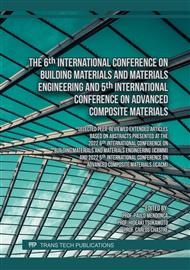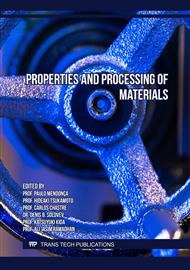p.111
p.117
p.125
p.131
p.139
p.145
p.151
p.157
p.165
Mechanical Evaluation of Geopolymeric Mortars Reinforced with Alpaca Wool Fibers
Abstract:
Reinforced geopolymeric mortars were obtained by mixing mine tailing, fine sand, alpaca wool fibers ( in variable amounts) sodium hydroxide and potable water, it was possible to verify the effect of the addition of alpaca wool on the mechanical behavior in uniaxial compression of the mortars studied. The mechanical data found revealed a systematic decrease in the maximum stress as the volume of wool added in the mortar mixtures manufactured increased. On the other hand, a higher degree of deformation was verified in mixtures with a greater volume of added fibers, reaching deformation values of up to 5%. The maximum strength values were in the range of 4 to 21 MPa for samples with 8 and 0 Vol. % of added fibers, respectively. Among the microstructural characteristics of the mortars studied, a continuous binder phase corresponding to the geopolymer could be appreciated, with sand particles and wool fibers dispersed within the binder phase. The real density and average porosity of the reinforced mortars were 2.65 g/cm3 and 32%, respectively.
Info:
Periodical:
Pages:
139-144
Citation:
Online since:
April 2023
Keywords:
Price:
Сopyright:
© 2023 Trans Tech Publications Ltd. All Rights Reserved
Share:
Citation:



